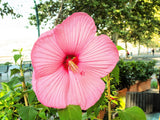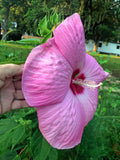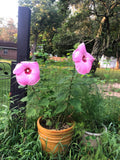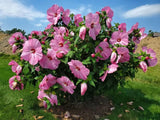Introducing Pink Elephant Hibiscus (Hibiscus moscheutos ‘Pink Elephant’) – the gentle giant of the swamp-mallow world. Plant these hardy seeds and grow a showstopper that’s as wild in charm as it is kind to wildlife.
🌸 Bloom & Appearance
-
Each bloom of Pink Elephant opens flat and wide—up to 12 inches (≈ 30 cm) in diameter—making it one of the largest hardy hibiscus flowers known.
-
The petals are a soft, medium pink, layered and slightly ruffled, surrounding a striking deep red (maroon) eye at the funnel’s throat.
-
It blooms from mid-summer into early fall, offering weeks of dramatic floral display.
❄ Hardiness & Growing Zones
-
Pink Elephant is winter hardy in USDA Zones 4 through 9 (some sources list 5–9, but many growers report success from zone 4 onward).
-
In colder regions, the plant dies back to the ground in winter and re-emerges from the perennial root system in spring.
🌿 Ecology & Wildlife Appeal
-
Though not notably fragrant, its large, open blooms act as a magnet for pollinators. Hummingbirds, native long-tongued bees, and the specialist Rose Mallow Bee (Ptilothrix bombiformis) visit for nectar and pollen.
-
The plant is a host for at least 28 species of butterflies and moths in the broader Hibiscus moscheutos group.
-
In particular, Pink Elephant (as a cultivar of H. moscheutos) supports caterpillars of the Painted Lady, Gray Hairstreak, and Common Checkered Skipper.
-
It also hosts more moth species in wild populations, such as Io moths, pearly wood nymph, yellow scallop moth, and others.
-
Dead and hollow stems serve as nesting sites for stem-nesting bees, adding further pollinator habitat.
🎭 Cultural & Historical Notes
-
The swamp-mallow (Hibiscus moscheutos) has deep roots in North American wetland traditions. In Indigenous and early settler usage, the mucilaginous stems were boiled and whipped (some liken it to marshmallow) and used as a mild thickeners or to disguise bitter medicines.
-
When hybridists developed ‘Pink Elephant’ (patented as PP21883), they selected for more overlapping petals, stronger coloration, and a longer blooming season than its parentage. It’s known to be more floriferous and robust than many earlier hardy hibiscus hybrids.
-
In some cultural symbolisms, hibiscus flowers represent elegance, beauty, femininity, or fleeting moments of splendor. A single giant pink flower opening each morning evokes theatrical drama and ephemeral delight to a garden stage.
🌱 Why Grow from These Seeds?
Planting Pink Elephant Hibiscus seeds gives you a chance to nurture a rare spectacle: giant pink flowers that dominate a summer garden, while fostering habitat for butterflies, moths, bees, and hummingbirds. Each bloom is a living billboard to pollinators and passersby alike.
Whether used as a border statement, in bog or rain gardens, or a dramatic vertical accent, these seeds offer both high drama and ecological value. Grow your own Pink Elephant and let your garden echo with the flutter of wings and the soft opening of a 12-inch blossom.










